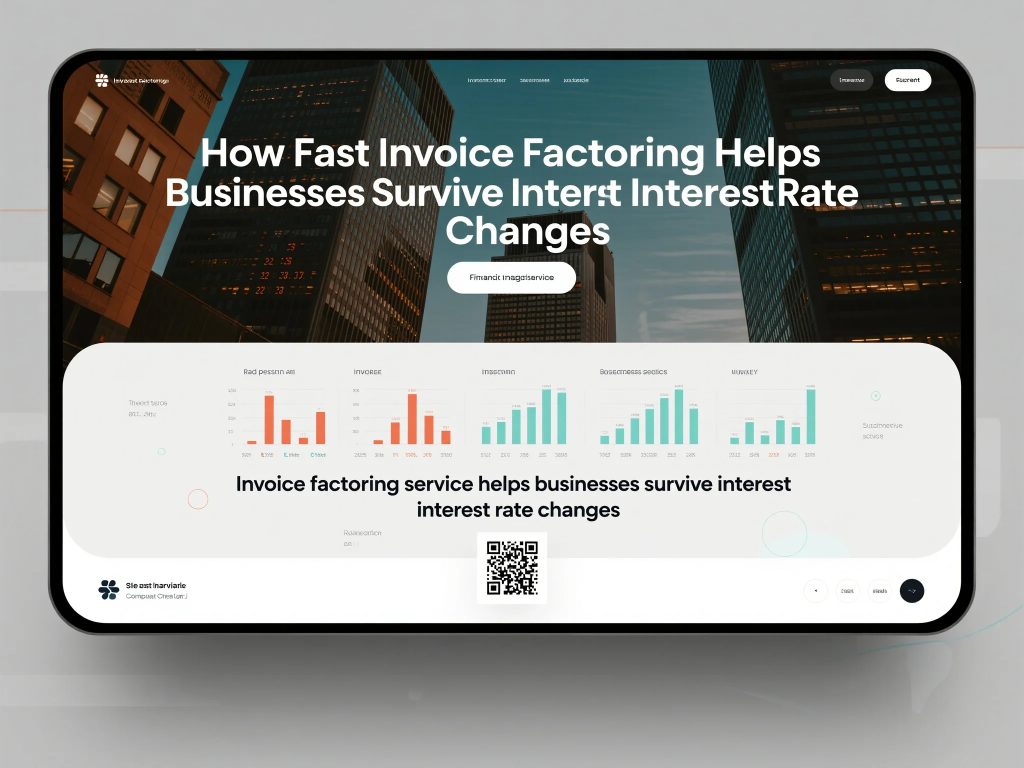Navigating Economic Uncertainty Through Innovative Financing Interest rate fluctuations create significant challenges for businesses across America, particularly affecting small to medium enterprises that operate with limited cash reserves. When the Federal Reserve adjusts rates, the impact reverberates through every aspect of commercial operations, increasing borrowing costs while potentially reducing consumer spending. Traditional bank loans become more expensive and difficult to secure during periods of rate hikes,
creating cash flow gaps that threaten business continuity and growth initiatives. Many companies find themselves caught between rising operational expenses and tightening credit conditions, struggling to maintain stability in an unpredictable economic landscape. This financial pressure often emerges at the most inopportune times – precisely when businesses need capital most for inventory management, payroll obligations, and strategic investments. The uncertainty generated by fluctuating rates complicates financial planning, making it increasingly difficult to forecast future expenses and revenue streams accurately. Companies with seasonal sales patterns or project-based revenue models experience this pressure most acutely, as their income rarely aligns perfectly with expense cycles. In this challenging environment, innovative financial tools like fast invoice factoring have emerged as crucial resources for maintaining operational stability. By understanding how interest rate changes impact their specific industry and financial position, business owners can make informed decisions about which financing options best protect their enterprises during economic uncertainty.The Transformative Power of Fast Invoice Factoring Fast invoice factoring provides businesses with immediate access to working capital by converting outstanding invoices into immediate cash, creating a powerful solution for navigating interest rate volatility. Unlike traditional loans that add debt to balance sheets, factoring operates as a sale of accounts receivable, providing capital without creating additional liabilities. The process begins when a business completes services or delivers
products to commercial customers, generating invoices with typical 30-90 day payment terms. Rather than waiting for these payments, the company sells these invoices to a factoring firm at a discount, receiving immediate funds that can cover operational expenses, expansion opportunities, or buffer against economic uncertainty. The factoring company then assumes responsibility for collecting payment from the customers, handling accounts receivable management and collection efforts. This arrangement proves particularly valuable during periods of rising interest rates when conventional financing becomes more expensive and difficult to obtain. The speed of this financing mechanism distinguishes it from other options, with many companies receiving funds within 24-48 hours of submitting invoices. This rapid access to capital allows businesses to maintain consistent operations regardless of customer payment patterns or economic conditions. The flexibility of factoring arrangements means companies can use the service continuously or selectively during specific need periods, creating adaptable financial support that aligns with actual revenue generation.Exploring Comprehensive Invoice Discounting Solutions
The landscape of invoice discounting solutions USA offers diverse options for businesses seeking to optimize their accounts receivable management while maintaining customer relationships. Unlike traditional factoring where the finance company assumes collection responsibilities, invoice discounting allows businesses to maintain control over their sales ledger and customer communications while still accessing early payment on outstanding invoices. This discreet approach appeals to companies concerned about how clients might perceive their financing arrangements, as the involvement of the financial provider remains transparent only to the business itself. Various discounting models exist across American markets, including selective discounting that allows businesses to choose specific invoices for financing rather than committing their entire accounts receivable portfolio. This flexibility proves invaluable for managing cash flow during interest rate fluctuations, as companies can access capital precisely when needed without long-term commitments. The cost structure of discounting typically involves interest charges based on how long funds remain outstanding, rather than the fixed percentage fees common in factoring arrangements. This difference can make discounting more economical for businesses with reliable customers who pay promptly. Many financial institutions offer online platforms that integrate with accounting software, providing real-time access to funding and detailed reporting on outstanding invoices and available credit limits. This technological integration creates seamless financial management experiences that help businesses navigate economic uncertainty with greater confidence and control.
Merchant Cash Advances as Strategic Financial Tools
Merchant cash advance companies provide alternative funding based on future credit card sales rather than accounts receivable, creating another option for businesses navigating interest rate changes. These advances work particularly well for retail businesses, restaurants, and other enterprises with consistent credit card transaction volumes, offering flexibility that traditional loans cannot match. The repayment structure aligns with business performance, as payments fluctuate based on daily sales volume rather than following a fixed amortization schedule. This feature proves especially valuable during economic uncertainty when revenue patterns might become less predictable. While costs are typically higher than conventional financing, the accessibility and speed of merchant cash advances make them attractive for businesses that might not qualify for traditional loans during tight credit periods. The application process focuses heavily on recent sales history rather than credit scores, making advances available to businesses with less-than-perfect credit but strong operational performance. Many providers offer streamlined online applications with funding within days, providing rapid response to urgent capital needs. This speed can be crucial when interest rate changes create unexpected cash flow challenges that require immediate attention. The best merchant cash advance companies transparently disclose all terms and costs, helping businesses make informed decisions about whether this financing tool aligns with their needs and financial situation.

Establishing Flexible Business Credit Lines
Securing a business credit line high approval option provides companies with revolving access to capital that can be drawn upon as needed, creating essential flexibility during periods of interest rate volatility. Unlike term loans that provide lump-sum funding with fixed repayment schedules, credit lines allow businesses to borrow precisely what they need when they need it, paying interest only on the amount utilized. This structure proves particularly valuable for managing cash flow gaps caused by economic fluctuations, seasonal patterns, or unexpected expenses. The application process for lines of credit typically involves thorough review of business financials, credit history, and operational performance, but certain lenders specialize in higher approval rates for qualified businesses. These financial institutions often focus on specific industries or business models where they have deeper understanding of risk factors and performance metrics. Once established, credit lines serve as financial safety nets that businesses can access immediately when opportunities or challenges arise. The revolving nature of these facilities means that as businesses repay borrowed amounts, those funds become available again for future use. This continuous access to capital helps companies navigate interest rate changes without constantly seeking new financing arrangements. Many lenders offer online management tools that provide real-time visibility into available credit, outstanding balances, and payment schedules, helping businesses maintain careful control over their borrowing practices.
Leveraging Asset-Based Lending Opportunities
Asset-based lending firms provide financing options secured by company assets including inventory, equipment, real estate, and sometimes intellectual property, creating borrowing opportunities even during periods of rising interest rates. These lending arrangements typically offer higher loan-to-value ratios than conventional loans because the secured nature reduces lender risk, making more capital available to businesses. The application process involves comprehensive appraisal of company assets to establish borrowing bases against which businesses can draw funds as needed. This approach proves particularly valuable for manufacturing companies, distributors, and other businesses with significant physical assets that might not generate the consistent cash flow patterns preferred by traditional lenders. The revolving nature of many asset-based credit facilities provides flexibility similar to lines of credit but with higher limits based on asset values rather than revenue history. Interest rates on asset-based loans typically remain more stable during Federal Reserve rate changes because the secured nature provides lenders with greater confidence in repayment. Many asset-based lenders specialize in specific industries, bringing deeper understanding of unique business cycles, valuation methods, and operational challenges. This specialized knowledge allows for more customized financing structures that align with how businesses actually use their assets and generate revenue. The ongoing monitoring of collateral values helps both lenders and borrowers maintain appropriate credit levels that reflect current business conditions.
Developing Comprehensive Financial Protection Strategies
The most financially resilient businesses often combine several financing methods to create comprehensive protection against interest rate fluctuations and economic uncertainty. Rather than relying exclusively on one funding source, savvy financial managers develop relationships with multiple providers offering different types of capital solutions. This diversified approach ensures that when one financing door closes due to market conditions, alternative options remain available. Many companies establish traditional banking relationships for conventional loans and lines of credit while simultaneously developing arrangements with alternative providers. This multi-pronged strategy provides flexibility to choose the most appropriate financing tool for each situation based on cost, speed, and terms. During periods of rising interest rates, businesses might increase their use of invoice financing to avoid taking on higher-cost debt, while when rates are low, traditional term loans might become more attractive. The integration of financial technology platforms has made managing multiple financing relationships increasingly efficient, with dashboard views of available capital across different providers and instruments. This comprehensive approach to business financing requires ongoing attention to market conditions and regular review of financing strategies, but the payoff comes in enhanced stability and readiness to capitalize on opportunities regardless of economic circumstances.
Implementing Strategic Financial Management Practices
Navigating interest rate changes successfully requires more than just access to various financing options – it demands strategic financial management that anticipates challenges and positions businesses for stability. Companies that thrive during economic uncertainty typically maintain conservative cash management practices during strong periods, building reserves that provide buffers when conditions change. They develop strong relationships with financial providers before urgent needs arise, ensuring that when capital requirements emerge, established channels exist for rapid response. These businesses implement rigorous accounts receivable management practices that minimize outstanding invoices and accelerate collections, reducing their reliance on external financing. They also maintain meticulous financial records that demonstrate stability and performance to potential lenders, simplifying the application process when additional capital becomes necessary. Regular review of financing costs and terms ensures that businesses don’t continue with expensive arrangements when better options become available. The most successful companies view their financing strategies as dynamic components of overall business planning, regularly reassessing their approach based on market conditions, growth plans, and economic forecasts. This proactive financial management, combined with appropriate use of innovative financing tools, creates resilience that helps businesses not just survive interest rate changes, but potentially thrive during them by capitalizing on opportunities that less-prepared competitors cannot pursue.




